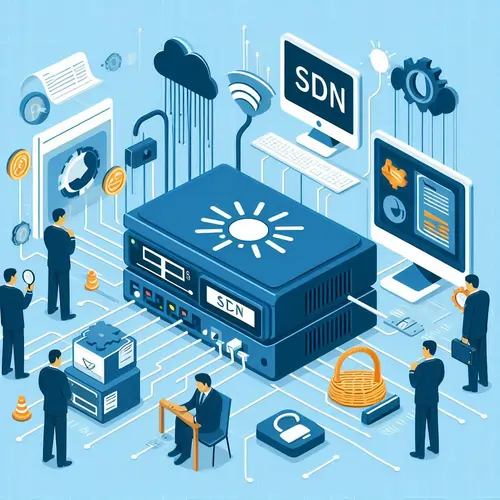- The Need for a Paradigm Shift in Networking
- Enter Software Defined Networking (SDN)
- Definition
- Key Components of SDN
- 1. Control Plane (Centralized Controller)
- 2. Data Plane (SDN Switches)
- 3. OpenFlow Protocol
- How SDN Works: A Simplified Walkthrough
- Advantages of Software Defined Networking
- Practical Use Cases of SDN
- SDN vs. Traditional Networking
- SDN Architecture Layers
- Challenges and Considerations
- Conclusion
In the evolving landscape of computer networking, Traditional approaches are increasingly facing limitations that hinder scalability, flexibility, and ease of management. Enter Software Defined Networking (SDN)—a transformative architecture that redefines how modern networks are designed, operated, and maintained. This blog, based on Lecture 43 of the Computer Networks and Internet Protocol course by Prof. Sandip Chakraborty of IIT Kharagpur, delves into the fundamentals of SDN, highlighting why it matters and how it changes the game.
If you are a student struggling with understanding advanced networking concepts like SDN or need help with your assignments, our specialized services in computer network assignment help are tailored just for you.
The Need for a Paradigm Shift in Networking
Traditional routers operate using two integrated components: the control plane and the data plane. The control plane handles routing decisions, while the data plane forwards packets based on those decisions. While functional, this architecture creates significant complexity, especially in large-scale networks.
One primary challenge is distributed control. Each router runs its own control plane, and these must coordinate to build a global view of the network. This setup not only introduces synchronization overhead but also suffers from scalability issues, inconsistencies, and vendor-specific configurations.
Protocols like Distance Vector and Link State Routing, though foundational, struggle when applied to large, complex networks. Updating routing policies across thousands of routers—often from different vendors with varying interfaces—is a cumbersome, error-prone task.

Enter Software Defined Networking (SDN)
SDN addresses these challenges by decoupling the control and data planes and centralizing network intelligence. At its core, SDN moves the control logic out of individual devices and places it in a centralized controller. This controller becomes the brain of the network, responsible for all decision-making processes, while switches (also called SDN switches) become simple packet-forwarding devices.
Definition
Software Defined Networking is a network architecture that separates the control function from the data forwarding function, centralizes network intelligence, and abstracts the underlying architecture from applications and services.
Key Components of SDN
1. Control Plane (Centralized Controller)
The controller is the cornerstone of the SDN model. It runs on standard computing hardware and acts as the decision-maker for the entire network. It processes incoming packets, decides routing strategies, and configures the switches accordingly.
Popular open-source controllers include:
- POX: Python-based, early SDN controller
- Ryu: Modern Python-based controller
- OpenDaylight: Java-based modular controller platform
- NOX: One of the first SDN controllers
- ONOS: Designed for scalability and reliability in service provider networks
2. Data Plane (SDN Switches)
SDN switches, unlike traditional routers, lack built-in intelligence. They rely on instructions from the controller. These switches typically include:
- TCAM (Ternary Content Addressable Memory): For fast rule lookup
- Switch Fabric: For data packet forwarding
- Minimal Processing Logic
3. OpenFlow Protocol
OpenFlow is the most prominent protocol enabling communication between the controller and SDN switches. It defines how the controller installs flow rules onto switches.
Each rule in OpenFlow is a simple match-action pair, e.g.:
- Match: Destination IP = 10.0.0.1/24
- Action: Forward to port eth0
How SDN Works: A Simplified Walkthrough
- Packet Arrival: Host H1 sends a packet to H3. The packet first reaches Switch S1.
- Switch Has No Rule: Since S1 doesn’t have a rule for this destination, it sends a "packet-in" message to the controller.
- Controller Decides: The controller analyzes the packet and determines the forwarding path. It then sends a "packet-out" message along with a flow rule to Switch S1.
- Rule Installation: S1 installs the rule in its TCAM hardware and forwards the packet to the next hop (e.g., S2 or directly to H3).
- Subsequent Packets: Future packets matching the rule are forwarded instantly without involving the controller, thanks to TCAM lookup.
Advantages of Software Defined Networking
- Centralized Management: Configuring, updating, and managing network policies becomes significantly easier with a central controller.
- Scalability: SDN allows networks to grow without synchronization and scalability issues of distributed architectures.
- Vendor Agnosticism: Network operators can choose hardware from different vendors without worrying about interoperability.
- Rapid Innovation: New network applications can be deployed directly into the controller without altering hardware.
- Enhanced Security: Rules can be dynamically created for firewalls or intrusion detection systems.
Example rules:
- Match: Destination IP = 172.16.20.0/24 → Action: Drop packet
- Match: Destination Port = 80 → Action: Drop packet
Practical Use Cases of SDN
- Campus Networks: Centralized policy management and routing for universities and enterprises.
- Data Centers: Dynamic path adjustment, load balancing, and VM management.
- Service Providers: Telecoms can deploy services like firewalls or VPNs via controller logic.
- Research and Education: Simulate real-world network behavior using general-purpose hardware.
SDN vs. Traditional Networking
| Feature | Traditional Networking | SDN Architecture |
|---|---|---|
| Control Logic | Distributed across routers | Centralized controller |
| Device Intelligence | Intelligent routers/switches | Dumb switches, smart controller |
| Vendor Lock-in | High, tightly coupled HW/SW | Low, interoperable standards (e.g., OpenFlow) |
| Flexibility | Low, hard to update or customize | High, programmable logic |
| Application Support | Limited, vendor-specific | Rich, custom application development |
| Configuration Effort | High, manual per-device config | Low, single-point configuration |
SDN Architecture Layers
- Infrastructure Layer: Comprising programmable switches and physical devices.
- Control Layer: The brain of the system—SDN controller managing routing, security, and applications.
- Application Layer: Custom-built applications like firewalls, load balancers, NAT, etc., running on top of the controller.
Each layer abstracts and interacts with the one below it, ensuring modularity and ease of development.
Challenges and Considerations
- Single Point of Failure: Backup and redundancy for the controller are critical.
- Learning Curve: Engineers must adapt to a software-centric approach.
- Performance Bottlenecks: Initial latency from controller-switch communication.
- Security: Centralized controller can be a target.
Despite these, SDN is becoming the foundation for modern, flexible, and scalable networks.
Conclusion
Software Defined Networking represents a significant leap forward in the way networks are managed and operated. By decoupling control logic from data forwarding, SDN brings about a new era of programmable, agile, and cost-effective networking. Whether you're a student, a researcher, or a professional, understanding SDN is essential for staying relevant in today’s tech-driven world.
If you're tackling an assignment on SDN or any other advanced networking topic and need help, we’re here to assist you with computer network assignment help. Our experts provide accurate, timely, and high-quality solutions tailored to your academic needs.
